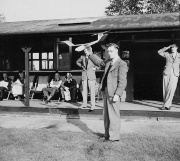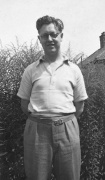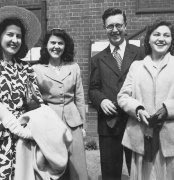I was admitted to Shrodells Hospital in Watford on the 5th of November 1947. Although penicillin had been used as an antibiotic since 1940 it was still not available in tablet form in 1947, so I was given intramuscular injections every four hours for five days. By the end of that treatment my bottom was like a pincushion, and I was told that the cost of penicillin was at that time quite alarming. I began to recover and the care could not have been better. Sister Dwight was in charge of the ward, and I guess that she thought that being 'ex-service' I should get the best possible attention. This included a daily bottle of brown ale and bringing me her own portable radio!
Unfortunately my temperature continued to yoyo and x-rays showed a patch on the apex of my right lung so there was a suspicion that I might have pulmonary tuberculosis (TB). I was kept in Shrodells Hospital until 10th January 1948. I was told I ought to go into a sanatorium, but because all the tests had been negative I said I would not do that. Instead I signed myself out of the hospital, but it was an amicable arrangement and I promised, and kept to it, that I would rest in bed for three months.
Pay from the studio had now stopped at my request because I thought they could not carry a 'passenger' for an indefinite period. The Hertfordshire County Council (HCC), as part of its fight against TB, had a grant available which paid us 39 shillings (£1/19/0) a week which was less than a quarter of my work pay. We also had two shillings and six pence a week from The Oddfellows, which was my medical insurance, and some help from the Red Cross. In July 1948 the National Health Service (NHS) started and we now got 42 shillings (£2/2/0) a week which was the same rate as the retirement pension for a married couple at that time. Now that I had support from the NHS the HCC grant ceased, but at that time I was receiving much more from the HCC than some who lived in other counties.
Dr Wood visited me most Sunday mornings but these were just friendly occasions. In March of 1948 Dr Dommen, who was a TB specialist, paid a call. He was pleased with my progress and said that I no longer had to stay in bed, but I had to rest a great deal. He said it was vital for me to go into Ware Park Sanatorium, but that I would be there for observation only. Because I had not taken the earlier advice I would have to wait three months for a place there.
The British Legion advised me to claim an army pension. The Ministry of Pensions replied with instructions to see their doctor in London. I checked with Dr Dommen and he said "No" emphatically! I then got a visit from the Ministry's doctor on the 14th of June. He wrote his report on the 8th of July, which I now know confirmed TB, that it was active and that I was waiting for admission to a sanatorium. He wrote "The general results are doubtful", whatever that meant. The Ministry asked for a report from the medical officer in charge of Shrodells who wrote to say that the test for TB were all negative, that there was no evidence of damage to the lung and "we were in fact uncertain whether this was unresolved pneumonia or a tuberculosis infection".
On 22nd July 1948 I entered Ware Park Sanatorium near Hertford. I was in good spirits. Before my departure a neighbour had called at the house but said "I don't want to see him, I want to remember him as he was" but I came out and she was amazed because by then I was not only feeling fit but I was also suntanned from all the days spent in the garden. The ambulance that called for me also stopped to pick up another patient, a teenage girl. All her family were in tears when she left them. She cried bitterly for a while but later she smiled when the attendant told us we would have good luck because a black cat had crossed our path. The cat survived but almost at our expense when the driver braked!
I arrived in time for lunch but afterwards I was terribly sick. This was a bad attack of panic, which was not surprising as I was fearful because I had been told that my Uncle Bert had died at Ware Park and that his mother, my grandmother, had also died of TB. I was given a bed in Cedar Ward and what I saw of the park looked good and I then began to think that perhaps it wouldn't be too bad there. The wards were wooden chalets and were open to the weather. There were even beds under the verandas which were occupied even in the most severe weathers.
On the 30th of August I had notification that my claim for a pension had been rejected. I told the British Legion and they said I should refuse to accept defeat so I appealed in writing on the 4th October 1948.
 |
| Me with a small sailplane. Ware Park, 1948. |
The treatment there was quite primitive, and only one antibiotic had proven to be effective against TB at that time. This was streptomycin which, in the available forms, had serious side effects. Only patients who were severely ill, of which there were few at Ware Park, and those who were prepared to say they accepted the risks of brain damage were given streptomycin. The most common treatment was AP (artificial pneumothorax) which meant collapsing the lung. Women patients had APP (artificial pneumoperitanea). These treatments involved injecting air into the chest cavity surrounding the lungs. For some reason men were injected into their armpit while women were injected below their ribs. My own treatment was only to be kept in bed for the first week and I then had complete freedom to do anything, except strenuous exercise, for the rest of my 'incarceration'.
Once again every test was negative and the doctors decided I could be discharged on October 23rd. I asked a doctor what I should do now and he said "Go home home and raise a family, but make sure your children get a BCG inoculation". When patients left Ware Park there was a friendly one-upmanship when it came to transport. Una, Mum and Dad arrived in a big chauffer driven Packard which Dad arranged from Durrant's Car Hire. Mr Durrant had been with Dad and me in the Home Guard.
Lack of exercise for a year had left me somewhat flabby and I spent the next three months getting really fit again. When I went to Dr Wood and said I wanted to return to work he advised me to take at least a month's holiday. When I said that we had little money left he said "Spend all you have!". Una and I went to Torquay and had a wonderful holiday. I remember that, on one of the few wet days in the month we were there, we stood in a shop doorway counting out our money to see if we could afford to buy an umbrella, and we laughed because we felt we no longer had anything to lose.
We were back to square one!
 |
 |
| Me after returning home from Ware Park, 1948. |
Me & Una at Arthur Gibson's wedding. 1949. |
I returned to work at Beecher Stow's studio in March 1949. There had been two additions to the staff: Ken Bromfield and Arthur Gibson. Beecher Stow insisted that I returned as Studio Manager but I considered this a little difficult because I was surrounded by very good and experienced designers and I had limited knowledge of what was now needed. However, everything went well.
 Home
Home